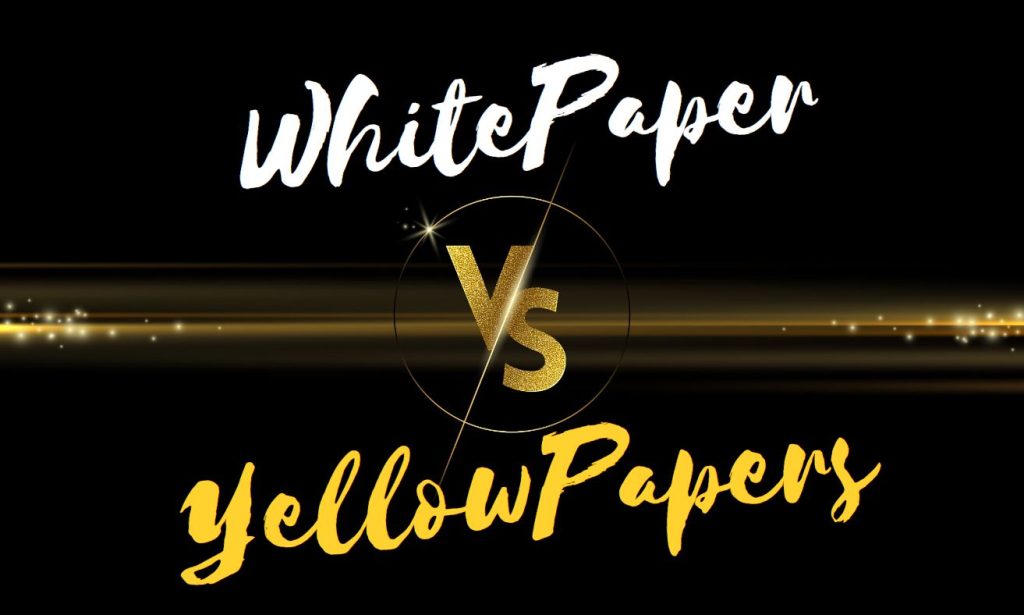In the lightning-speed world of cryptocurrencies, finding your way through the labyrinth of information can be a herculean task. For anyone venturing into the crypto space, whether as a seasoned investor or a newbie, understanding the terrain is crucial. And in this terrain, two documents often stand out due to their significance: white papers and yellow papers. These documents serve as comprehensive guides, providing insights into various crypto projects. However, despite their shared importance, many often confuse white papers with yellow papers or use the terms interchangeably. The truth, however, is that they’re as different as chalk and cheese. Let’s unravel the mystery and delve into the nuances of these two critical documents and compare the White Papers vs Yellow Papers.
Key Differences Between White Papers and Yellow Papers
White papers vs yellow papers play unique roles in the lifecycle of a crypto project. While both are essential, they cater to different aspects and audiences.
The white paper is the birth certificate of a crypto project, so to speak. It’s a comprehensive report that outlines the purpose and mechanics of the project. Like a movie trailer, it offers a sneak peek into the project’s intent, value proposition, and how it plans to shake things up in the market. The language used in white papers is often less technical and more accessible, designed to appeal to a broad spectrum of readers. Hence, it’s common to find a blend of marketing language and technical details in a white paper.
On the other hand, the yellow paper is the technical manual of a crypto project. It’s a document that delves into the intricate details of how the proposed blockchain system will function. Imagine it as a blueprint for a highly complex machine. It offers a thorough explanation of the project’s technical aspects, algorithm descriptions, mathematical proofs, and other intricate technical information. Unlike the white paper, the yellow paper is not meant for light reading. It’s a technical manuscript, designed for tech-savvy readers interested in understanding the nuts and bolts of the project.
While the white paper provides an overview and appeals to a broader audience, the yellow paper presents a deep dive into the project’s technical aspects. Both are essential and contribute uniquely to the project’s comprehensibility and transparency. Understanding the key differences between them helps stakeholders and potential investors navigate the crypto universe with more confidence and insight.
Evaluating the Quality of Both Types of Papers
In the gold rush of the crypto world, white papers and yellow papers serve as the trusty map and compass, guiding us through the rough terrain of this novel market. But not all maps are created equal, and the quality of these documents can vary greatly from one project to another.
A top-notch white paper should be clear, concise, and comprehensive. It should clearly articulate the project’s goals, the problems it aims to solve, and the solutions it proposes. It should detail the token’s distribution and the project’s roadmap. Beware of white papers that are vague, lack specifics, or are peppered with buzzwords and jargon without substance. A high-quality white paper should be informative and persuasive without resorting to hype or over-promising.
On the flip side, a yellow paper’s quality can be assessed through its depth of technical information. A good yellow paper should offer intricate details about the project’s underlying technology, including algorithms, system architecture, and security protocols. It should delve into the technical aspects of the project in a rigorous and precise manner. If a yellow paper lacks these details or seems superficial, it might indicate that the project’s technical foundation is shaky.
The Roles of White Papers and Yellow Papers in Crypto Investment Decisions
As an investor, you want to put your money where it’s likely to grow. But with the crypto world being as vast and varied as it is, making investment decisions can feel like shooting in the dark. That’s where white papers and yellow papers come in.
A white paper serves as a snapshot of the project, providing an overview of its aims, solutions, and strategies. It can give investors an understanding of the project’s unique selling proposition and its potential for success. Reading a project’s white paper can provide a sense of the project team’s vision, their understanding of the market, and their strategy for achieving their goals.
The yellow paper, meanwhile, can provide assurance about the project’s technical soundness. For those with the requisite technical knowledge, a yellow paper can offer insights into the feasibility and robustness of the project’s technology. It can reveal whether the project’s tech can deliver on the promises made in the white paper, making it an invaluable tool for assessing the project’s potential for success.
To sum up, while the white paper can provide insights into a project’s market potential, the yellow paper can shed light on its technical viability. Both documents are critical to making informed investment decisions in the crypto world. Armed with these tools, investors can navigate the crypto landscape with greater confidence and discernment.









